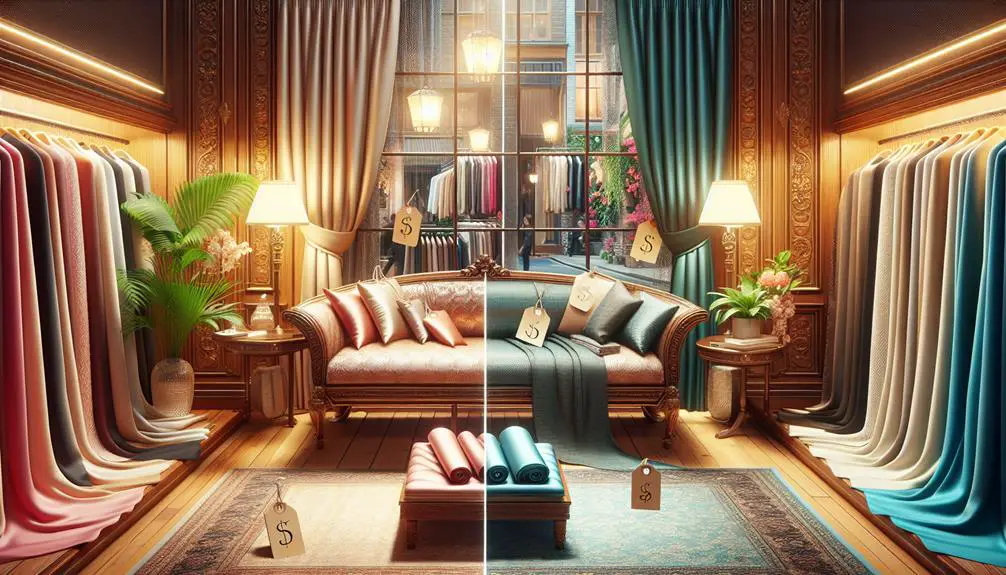Yeah, I'd say nylon is generally considered a cheap fabric. It was first marketed as a less expensive alternative to silk and it's produced in huge quantities, which keeps its price down. Plus, it's super versatile and durable, used in everything from stockings to backpacks. Despite its low cost, it offers good value because it's strong and lasts a long time. However, while it's affordable, factors like production scale and advancements in manufacturing techniques can influence its price a bit. There's definitely more to learn about why nylon's priced the way it is and how it compares to other fabrics.
Table of Contents
Key Takeaways
- Nylon was initially marketed as a cost-effective alternative to silk.
- It has become more affordable due to large-scale global production.
- Despite its durability and versatility, nylon remains competitively priced.
- Market trends indicate a decline in nylon's cost over time.
- Compared to other synthetic fabrics, nylon offers a good value for its price.
Understanding Nylon Fabric
Nylon, initially marketed as a cheap alternative to silk, is known for its affordability and widespread availability. When I think about why nylon is seen as a budget-friendly option, it really boils down to its production. Unlike some fabrics that require more complex and costly methods to produce, nylon's production process is quite cost-effective. This helps keep its price lower, which is a huge win for folks like me who want good quality without breaking the bank.
Now, you might wonder what makes nylon so special aside from its price. Well, it's incredibly durable and versatile, which means it can be used for a whole range of products – from clothing to camping gear. This versatility also means manufacturers produce it in large quantities, which further drives down its cost through economies of scale.
Production Process of Nylon
Let's dive into how they actually make nylon, starting with the creation of nylon salt from hexamethylenediamine and adipic acid. This initial step is crucial as it forms the foundation of the nylon manufacturing process. By combining these two chemicals, they produce a polymer precursor known as nylon salt.
The journey of turning nylon salt into the fabric we all know involves a series of meticulous steps and treatments:
- Heating and Extruding: The nylon salt undergoes heating and is then extruded through a spinneret, a device resembling a showerhead, which shapes it into long, thin strands.
- Cooling and Hardening: As the strands exit the spinneret, they're cooled and hardened into fibers. This transition is vital for the fibers' strength.
- Stretching for Strength: Post-hardening, the fibers are stretched, significantly enhancing their strength and elasticity.
- Winding: Finally, the fibers are wound onto bobbins, preparing them for the next stages of production where they can be spun into garments or other products.
Throughout these stages, specific chemical reactions and treatments are applied to ensure the nylon not only holds up but excels in both durability and versatility. This complex process highlights why nylon is far from being just a 'cheap' fabric.
Common Uses of Nylon
After exploring how nylon is made, I'll now cover its various applications in everyday items and industrial products. It's incredible how versatile nylon fabrics are, really stretching their use from our wardrobes to the great outdoors.
For starters, nylon's used a lot in clothing. Think stockings and swimsuits where the fabric's stretchiness and durability are key. But that's not all. It's also big in home furnishings like sofas and carpets, where it stands up well to daily wear and tear.
Nylon is also a champ in industrial settings. You've got it in conveyor belts and safety harnesses because it can take a lot of stress and strain without giving up. Plus, its strength makes it ideal for heavy-duty items like tire cords.
When it comes to outdoor gear, nylon really shines thanks to its moisture-wicking properties and resistance to water. It's the go-to material for stuff like tents and backpacks that need to handle the rough and tumble of nature.
Here's a quick look at some key uses:
| Application Area | Example Products | Why Nylon? |
|---|---|---|
| Clothing | Stockings, Swimwear | Stretchy, durable |
| Home & Furnishings | Carpets, Sofa | Resilient |
| Industrial | Conveyor belts, Ropes | Highly durable |
| Outdoor Gear | Tents, Backpacks | Water-resistant |
It's pretty clear that nylon isn't just a cheap fabric—it's a powerhouse material!
Global Nylon Production Sites
Exploring the global landscape, I'll start with how nylon production sites are spread across key regions like the United States, China, Japan, and Germany. Diving into the specifics:
- United States: It's got a solid footing in the nylon industry, especially in states like North Carolina. The production of nylon here is well-established, making it a crucial player on the global stage.
- China: This country's climbing the ranks fast in the nylon sector, with an increasing number of factories popping up. They're really pushing the expansion of their production capabilities.
- Japan: Known for its cutting-edge technology, Japan focuses on high-quality and innovative nylon products. They're all about precision and top-notch materials.
- Germany: Over here, they're big on integrating sustainability with their advanced manufacturing techniques. It's not just about making nylon; it's about making it right.
Each of these countries contributes uniquely to the global narrative of nylon production. Whether it's the United States' historical depth or China's rapid expansion, the production landscape is as diverse as it's dynamic. This global spread not only highlights the importance of nylon but also the different approaches and priorities each region holds toward its production.
Pricing Analysis of Nylon
When I look at nylon, I see that its production costs have dropped because we've gotten better at making it.
I'm curious how these costs compare to what we see in the market and how they stack up against other synthetic fabrics.
Let's see what's going on with the prices and how nylon holds up in the big picture.
Nylon Production Costs
Nylon's production costs have dropped over time, making it a more budget-friendly option for many. Let's break down why this synthetic fiber's pricing is more appealing these days:
- Global Production Scale: Increased manufacturing has driven down costs due to the competitive market.
- Durability and Longevity: Nylon outlasts many natural fibers, offering more bang for your buck.
- Versatility: It's used across various industries, from clothing to automotive, which stabilizes its price.
- Environmental Impact: Advances in production methods are aiming to reduce the environmental footprint, potentially lowering costs further.
Understanding these points helps us see how the pricing of nylon remains affordable while still offering quality and versatility.
Market Pricing Trends
Let's dive into how the prices of nylon have trended downwards, making it an even more economical choice for consumers. As a synthetic fiber, nylon's affordability is a big win.
The market pricing trends reveal a noticeable drop in costs over the years. This fall in price is largely due to the efficiency in its production and its widespread availability, which keep it competitive in the fabric market.
Plus, nylon's versatility and durability mean you're getting great value for your money. It's incredibly budget-friendly without skimping on quality.
Comparing Synthetic Fabrics
In comparing synthetic fabrics, nylon often stands out for its slightly higher price, which reflects its superior strength and abrasion resistance. It's not the cheapest, but you're getting good bang for your buck considering what it offers. Here's why it's worth it:
- Durability: Nylon's tough nature means it lasts longer than many other fabrics.
- Performance: It excels in various conditions, making it ideal for both outdoor gear and everyday apparel.
- Affordability: Despite being pricier than some synthetics, it's still cost-effective for the quality you get.
- Versatility: It's used in everything from parachutes to pantyhose, proving its wide range of applications.
Varieties of Nylon Fabrics
When we look at nylon, it's not just one thing; there are different types each suited for specific uses.
We've got everything from the tough and durable Nylon 6, which is great for activewear, to the flexible Nylon 12, perfect for protective clothing.
Let's explore how these fibers are made and how their durability and weaving techniques contribute to their versatility and cost.
Nylon Fiber Types
Nylon comes in various types, each with unique properties and uses. Delving into how nylon is made reveals its versatility in synthetic fiber production, leading to different types of nylon fabric suited for specific applications.
- Nylon 6,6: Ideal for swimwear and outdoor gear due to its waterproof nature.
- Nylon 6: Lightweight and tough, often used in activewear and bags.
- Nylon 6,10: Known for its strength, chemical resistance, and durability, making it perfect for car parts and sports gear.
- Nylon 12: Offers flexibility with low moisture absorption, great for electrical insulation and protective clothing.
Each type offers distinct benefits, making nylon a remarkably adaptable material in various industries.
Durability of Nylon
Exploring the various types of nylon fabric, it's clear that their durability is a standout feature, making them ideal for everything from everyday clothing to specialized industrial applications.
Take Nylon 6,6, for instance; it's not only tough but also waterproof, which is why it's so great for outdoor gear.
Then there's Nylon 6 and Nylon 6,10, both of which are lightweight yet strong, perfect for activewear that needs to endure.
Nylon 4,6 shows off with its resistance to heat and chemicals, often picked for car parts and safety gear.
Lastly, Nylon 12 shines with its flexibility and minimal moisture absorption, suited for protective clothing and electrical insulation.
It's no wonder the different types of nylon are so widely used!
Nylon Weaving Techniques
Diving into the world of nylon, various weaving techniques craft fabrics like taffeta, chiffon, and ripstop, each designed for specific uses. The versatility of these weaving methods allows for a wide range of applications, making nylon fabric anything but mundane. Here's a quick look at how diverse nylon can be:
- Plain Weave: Simple yet strong, used for nylon taffeta which is slick and crisp.
- Twill Weave: Creates diagonal patterns, ideal for durable items like ballistic nylon.
- Satin Weave: Offers a glossy surface, perfect for luxurious nylon chiffon.
- Ripstop Weave: Incorporates reinforcement to prevent tears, essential for outdoor and military gear.
Each technique enhances the nylon's attributes, tailoring it to meet specific performance demands.
Environmental Effects of Nylon
The production of nylon significantly harms the environment due to its reliance on crude oil and energy-intensive processes. When you dig deeper into how nylon is made, it's clear that this fabric isn't just about fashion or durability. Nylon production starts with extracting crude oil, which is a dirty business in itself. The process doesn't end there; turning that oil into nylon fibers consumes a lot of energy and emits tons of greenhouse gases. This makes the environmental impact of nylon quite severe.
Now, let's talk about what happens once nylon has served its purpose. Since nylon is non-biodegradable, it hangs around in landfills for ages. You've probably seen those heartbreaking pictures of wildlife tangled in plastic waste; well, nylon contributes to that problem. The disposal challenges are real because nylon doesn't break down easily, and recycling options are limited. This means most of it ends up as environmental pollutants, sitting there for decades.
Certifications for Nylon Fabrics
When I'm checking out nylon fabrics, I always look for certain certifications that tell me a lot about their quality and impact on the planet.
Certifications like Oeko-Tex or Bluesign mean the fabric meets high standards for environmental safety and production ethics.
It's not just about how durable the fabric is, but also how it's made and its overall eco-friendliness.
Nylon Fabric Standards
Let's explore the various certifications that ensure the quality and sustainability of nylon fabrics. When you're buying nylon, these certifications mean you're getting a product that meets strict standards.
- Oeko-Tex Standard 100: This certification ensures that nylon fabrics are free from harmful substances. It's a must for safety in textiles.
- Bluesign certification: Focuses on sustainable production processes, ensuring that the manufacturing of nylon is safe for both the environment and workers.
- GRS (Global Recycled Standard): Indicates nylon fabrics made from recycled materials, promoting sustainability.
- ISO 9001: Ensures that manufacturers have robust quality management systems in place, which leads to higher quality nylon fabric.
These certifications help you choose high-quality, responsibly made nylon products.
Eco-Friendly Nylon Certifications
Several eco-friendly certifications exist for nylon fabrics, ensuring they meet rigorous environmental and safety standards. The OEKO-TEX Standard 100 is a big deal because it makes sure the nylon I'm buying doesn't have any harmful substances. That's really reassuring, right?
Then there's the Bluesign certification, which is all about sustainable production. It guarantees that the nylon fabric is produced in a way that's safe for both the environment and workers.
And let's not forget the Global Recycled Standard (GRS). It encourages the use of recycled materials in making nylon, which helps reduce the environmental impact. I always try to look for GRS-certified nylon to support sustainable practices—it's a simple way to help our planet.
Durability Testing Protocols
While eco-friendly certifications focus on environmental and safety standards, durability testing protocols like ASTM D3884 and ISO 12947 assess how tough and long-lasting nylon fabrics are. These standards are crucial for ensuring that the nylon you buy isn't just durable, but consistently so.
- ASTM D3884: Measures the abrasion resistance of fabric, showing how well it can withstand wear from rubbing.
- ISO 12947: Focuses on how the fabric handles repeated stress, particularly useful for areas of clothing that bend a lot.
- Tear Strength: This test checks how much force is required to tear the fabric, an essential factor for high-stress applications.
- Consumer Assurance: Products with these certifications give buyers confidence in the fabric's longevity and quality.
Nylon Versus Polyester
When comparing nylon and polyester, it's clear that each fabric offers distinct advantages and disadvantages. Let's dive into some specifics, starting with abrasion resistance, durability, and affordability.
Nylon really shines when it comes to abrasion resistance. This means it's tougher in situations where there's a lot of wear and tear. I've noticed that my nylon gear holds up better during outdoor activities compared to polyester items, which tend to show wear sooner. In terms of durability, nylon also takes the lead. It's generally considered a premium material because it's stronger and lasts longer. This is why you'll often find it in high-end outdoor gear designed to withstand harsh conditions.
However, when we talk about affordability, polyester often has the upper hand. It's typically cheaper than nylon, making it a go-to for those who are budget-conscious. This cost difference makes polyester a popular choice in a wide range of clothing, not just outdoor gear.
Comfort and Allergies Concerns
Moving onto comfort and allergy concerns, it's important to note that nylon's lack of breathability can lead to increased sweating and discomfort for some wearers. This synthetic fiber, while versatile, doesn't always hit the mark when it comes to comfort, especially compared to natural fibers like cotton.
Nylon's potential shortcomings in the comfort department are crucial for me to understand, especially since I'm always on the lookout for clothes that not only look good but also feel good. Here's a quick rundown of key points:
- Breathability: Nylon traps heat and moisture, which can make it feel uncomfortable in warmer climates or during physical activity.
- Skin Irritation: Due to its synthetic nature, nylon can cause skin irritation, particularly for those with sensitive skin.
- Allergy Concerns: Some individuals might experience allergic reactions to nylon, which is an important factor to consider for anyone prone to allergies.
- Comfort Comparison: It generally doesn't match the comfort level provided by fabrics like cotton, which are softer and more skin-friendly.
Understanding these aspects helps me make more informed choices regarding what fabrics to wear to stay comfortable and reduce potential skin irritation.
Care Instructions for Nylon
Caring for nylon clothes is pretty straightforward, as they're machine washable and dry quickly. You don't have to fuss over them too much, which makes them great for a busy lifestyle. I always make sure to use a mild detergent and stick to cold water; this keeps my nylon garments looking sharp and vibrant without much effort.
Here's a quick rundown of the key care instructions for nylon:
| Do's | Don'ts |
|---|---|
| Wash in cold water | Use bleach |
| Use mild detergent | Wash in hot water |
| Air dry if possible | Tumble dry on high heat |
| Iron on low heat | Ignore care labels |
| Check care labels | Assume all nylon is the same |
Manufacturing Challenges With Nylon
Producing nylon isn't straightforward, as it involves complex chemical reactions that require precise control over temperatures and pressures. Delving into the manufacturing challenges of nylon production, I've learned that the temperature and pressure settings are crucial for ensuring that the chemical reactions occur correctly to form the desired nylon polymer. Any slight deviation can lead to inferior quality, which isn't something manufacturers or consumers want.
Here are some key points about the manufacturing challenges:
- Complexity of Chemical Processes: The synthesis of nylon involves caprolactam or adipic acid reacting with hexamethylene diamine, which needs exact conditions to achieve the right molecular structure.
- Large-Scale Facilities: Handling these reactions requires substantial infrastructure, which includes large reactors and precise control systems to maintain stability throughout the process.
- Quality Control: Consistency is king in nylon production. Rigorous quality control measures are essential to ensure that each batch of nylon meets stringent standards for strength, elasticity, and durability.
- Innovation in Manufacturing: Overcoming these challenges has spurred technological advancements, leading to more efficient processes and improved quality of the final product.
Understanding these aspects helps us appreciate why nylon, despite its challenges, remains a staple in the fabric industry.
Frequently Asked Questions
Is Nylon High Quality?
Yes, I'd say nylon is high quality. It's durable, strong, and versatile, making it great for outdoor gear and many other products where you need something that'll last and perform well.
Is Nylon Fabric Expensive?
Nylon fabric isn't typically expensive. It's made through cost-effective processes, making it a budget-friendly choice for many items like clothes and accessories. Its affordability also leads to its wide use in various products.
Is Nylon Cheaper Than Cotton?
Yes, I've found that nylon is generally cheaper than cotton. Its synthetic production keeps costs low, making it a budget-friendly option for many clothes and accessories without sacrificing much in terms of durability.
What Are the Disadvantages of Nylon Fabric?
Nylon's drawbacks include environmental harm, as it's non-biodegradable and production is energy-intensive. It also may cause skin irritation and has associated health risks, making sustainable alternatives important to consider.
- Why Is Red Velvet Not Red? - April 25, 2024
- How Do You Describe Velvet Fabric? - April 25, 2024
- How Strong Is Velvet? - April 25, 2024








